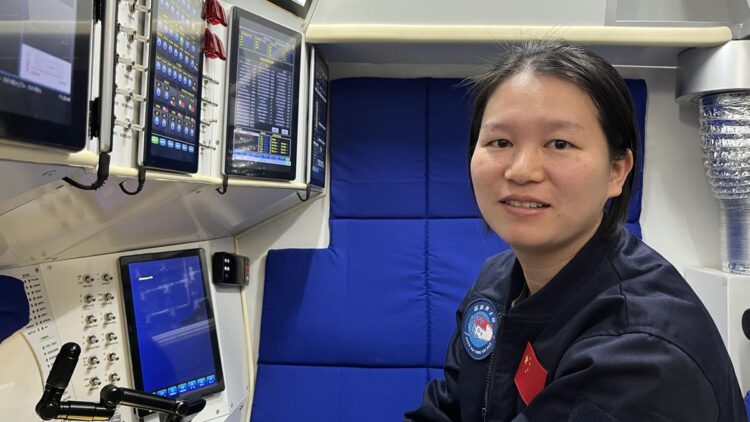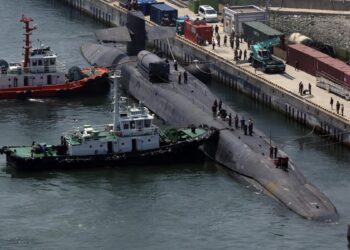
Li Hangzhou, a submersible pilot, at the Institute of Deep Sea Science and Engineering in Sanya, China.
| Photo Credit: Ananth Krishnan
It is usually the sightings of the Chinese military’s latest warships, and the occasional submarine, that attract the most attention in the crystal clear waters off this tropical island in the South China Sea.
Less noticed are the departures of the Explorer 2, a green-and-white vessel that might pass for an unremarkable trawler.
Departing from Sanya’s Institute of Deep Sea Science and Engineering (IDSSE), the vessel has made increasingly frequent forays into some of the least explored parts of the world’s oceans, carrying with it one of the most advanced deep-sea submersibles, as well as China’s ambitions to dominate the still evolving, yet highly competitive, field of deep sea exploration.
So important is the IDSSE’s mission to Beijing that when the manned submersible Fendouzhe, or Striver, plunged to a then record depth of more than 10,000 metres in 2020, Chinese President Xi Jinping sent a letter to the institute, pointing out that “the success of the Fendouzhe marks China’s ability to enter the world’s deepest oceans to carry out scientific exploration and research, and reflects the nation’s comprehensive strength in marine high technology fields.” Only the U.S., France and Russia have similar capabilities, according to Chinese scientists.
Researchers at the IDSSE say their main mission is understanding what lies at the depths of little understood ocean trenches. The work of deep sea research does, however, also carry the promise of unlocking untold commercial riches, given the growing global interest into deep sea exploration of mineral resources. Copper, gold, minerals and rare earth elements remain untapped on the sea bed.
“How are organisms adapted to life in the extreme environment of the ocean, in this least understood and remote environment? That is what we are exploring,” said Zhang Weijia, a deputy researcher at the IDSSE. Ms. Zhang said scientific research is also important in determining how resources can be exploited without damaging ocean environments. “From the ecological perspective, it will be helpful to monitor long-term changes to mining areas, how long it takes to recover, and so on,” she said.
In December 2021, the Striver explored the Mariana Trench, the world’s deepest. At the Kermadec Trench in the Pacific Ocean, Ms. Zhang said, the submersible created several firsts, observing for the first time anemones at a depth of 8,880 metres and fish feeding on shark remains at 9,900 metres. “The biggest surprise is we observed a rich food supply at these depths,” she said.
In the Mariana Trench, new microbes were discovered. The research is at an early stage, but the potential for biotechnology, from new enzymes to treating anti-microbial resistance, is enormous.
The scientific mission of the IDSSE, which is jointly run by Beijing’s elite Chinese Academy of Sciences (CAS), the country’s premier scientific institution, and the Hainan provincial government, is in line with Mr. Xi’s current push to establish China as a science and technology power. The institute has been given 30 billion Yuan ($4.3 billion) in grants for the 400 projects it is currently pursuing.
Its mission is to create “a China-led global deep sea scientific research programme with joint participation by numerous major international deep-sea research teams”. The Kermadec project was run along with New Zealand, while IDSSE is China’s designated member of the BRICS “Marine and Polar Science” working group.
It isn’t only global scientific prestige that is motivating Beijing to pour money into deep sea research. The work of China’s advanced submersibles is also boosting the efforts of the China Ocean Mineral Resource R&D Association (COMRA), a government-backed body spearheading Beijing’s plans to develop the world’s most advanced deep-sea mining capabilities.
China, along with the U.S., Russia, Germany, France, and to a lesser extent, India, are in a race for exploration contracts to search the vast areas under the jurisdiction of the International Seabed Authority (ISA), which includes all waters beyond 12 nautical mile territorial seas and 200 nautical mile exclusive economic zones. China has so far secured several exploration licences in vast areas in the Pacific Ocean and Indian Ocean.
On February 27, 2023, Hong Wang, a senior Chinese official who is Vice-Minister of Natural Resources and Administrator of Oceanic Administration, visited the ISA headquarters in Jamaica, underlining the importance accorded by China to this project. “The ISA is entrusted with a critical mandate and plays a fundamental role in the global ocean architecture,” he said then. “China strongly supports the mission of ISA to protect the marine environment and sustainably develop mineral resources… for the benefit of all humanity.”
















